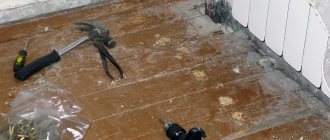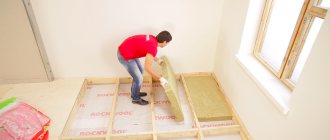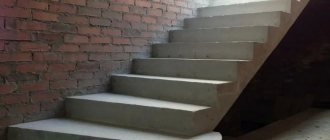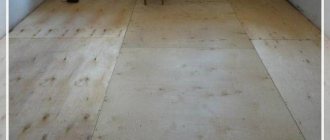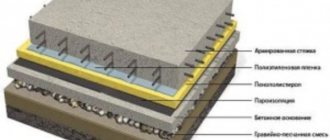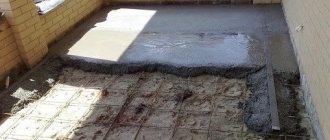Concrete is used not only for the construction of foundations and walls, but also for the construction of floors. A distinctive feature of concrete is the durability and strength of the material. However, a cold floor surface causes serious inconvenience, since the thermal conductivity of concrete is increased. When deciding to build a warm concrete floor, you have to decide how to insulate the base. It is important to choose the right insulation for a concrete floor and understand how thermal insulation materials are laid on the surface and waterproofing is performed.
Concrete floor base in a private house - features of a concrete slab
The floor is a critical element of the structure. Trying to increase the service life of a building, many people prefer concrete. After all, concrete surpasses most building materials in terms of performance characteristics. But along with a set of advantages, the material also has weaknesses.
Concrete has superior performance characteristics to most building materials.
Let's start with the main advantages of concrete floors, which include the following characteristics:
- increased safety margin. The concrete surface is able to withstand significant compressive loads, maintaining the structure and integrity of the mass;
- long period of use. The service life is commensurate with the service life of the building, thanks to the durability of the base;
- environmental cleanliness. The ingredients included in the concrete mixture are safe for health and do not harm the environment;
- ability to resist the accumulation of static electricity. Airborne dust is not attracted to the surface;
- Fire safety. The concrete base has increased fire resistance and is not destroyed by open fire;
- resistance to capillary penetration of moisture. Despite the reduced hygroscopicity, waterproofing the floor is a prerequisite;
- resistance to aggressive environments and chemicals. The concrete base is not destroyed upon contact with acids and alkaline compounds;
- maintainability. If necessary, it is easy to repair the damaged area.
Thinking about which insulation for a concrete floor is best, let’s look at the disadvantages of a concrete base. Main disadvantages:
- increased thermal conductivity. Without additional thermal insulation, significant heat loss occurs;
- condensation formation. Due to the increased temperature difference between the soil and the floor of the lower floor, moisture condenses on the concrete surface.
The concrete base has increased fire resistance.
Condensation causes a number of negative factors;
- increased indoor humidity;
- deterioration of the internal microclimate;
- development of fungal colonies and mold;
- formation of dampness.
In addition, in winter, cold floors cause many inconveniences to residents:
- reduce indoor temperature;
- increase heating costs.
But, thanks to a serious set of advantages, many people build a concrete floor. How to insulate its surface to avoid heat loss is of interest to owners of private houses, summer cottages and novice developers. Let's try to answer this question.
Structure of mineral wool
The canvas is based on molten rocks, glass or slag.
According to special technology, the finest fibers are obtained from them. The molten substance enters the centrifuge, is inflated with air and, under the influence of centrifugal forces, is stretched into extremely thin fibers. After deposition in a special chamber, the randomly intertwined fibers are combined into a fabric with a loose porous structure using binding polymers. Depending on the raw materials used in production, cotton wool is distinguished:
- glass or glass wool;
- stone, mainly basalt or other volcanic rocks;
- slag, it is based on blast furnace slag.
The resulting material may vary in structure, since usually, depending on the raw material, the nuances of the technology used may differ. It happens:
- vertically or horizontally layered;
- corrugated;
- spatial.
Thermally insulating a concrete floor: how to insulate the surface of a concrete base
Specialized stores offer many different heat insulators with different performance characteristics. Many people prefer traditional materials and believe that for insulation it is enough to lay a layer of foam plastic or expanded clay granules. However, the choice of thermal insulators is not limited to this.
When choosing insulation for concrete floors, also pay attention to the following materials:
- mineral or basalt wool. They are a budget solution and belong to fibrous heat insulators;
- sheet expanded polystyrene. It has proven itself positively in rooms with high moisture concentration;
The choice of thermal insulators today is very large
- polyurethane foam. The material is sprayed onto the concrete surface using special equipment;
- wood sawdust. They allow you to thermally insulate a concrete base at low cost;
- polymer-based thermal insulation mixtures. Used when installing heated floors;
- heat-insulating paint. It is applied in liquid form to the surface of the concrete floor, insulating it;
- foam glass. Offered in the form of environmentally friendly blocks with increased moisture resistance;
- cork material. It consists of pressed slabs made from natural wood.
When deciding on a heat insulator, consider the following points:
- working properties of insulation. The efficiency of thermal insulation and service life depend on them;
- features of the building. The specifics of insulating concrete floors in a private house, multi-story building or country house are different;
- location of the concrete floor in the building. Possible options are the floor above the basement, the floor of the lower floor or the interfloor foundation;
- insulation method. Thermal insulation materials are used or a heated floor system is installed;
- location of the heat insulator. The insulation is placed between the joists or placed on the surface when screeding.
Let us dwell in more detail on the main operational properties of the heat insulators used.
Main characteristics of insulation:
- density. With an increase in specific gravity, the strength characteristics increase, but the thermal insulation properties decrease due to a decrease in porosity;
- margin of safety. The load capacity of the thermal insulation material affects its durability and allows it to maintain its original shape under load;
- thermal conductivity. Maximum insulation efficiency is achieved when using materials with reduced thermal conductivity;
Reliable thermal insulation depends on the thermal insulation materials used.
- moisture resistance. To insulate the concrete base, use insulation materials with reduced hygroscopicity;
- vapor permeability. Due to the ability of the material to pass vapors, the efficiency of air exchange increases;
- exploitation resource. Durability is one of the determining factors when deciding on floor insulation;
- weight. Give preference to lightweight thermal insulators that have sufficient density;
- environmental cleanliness. Try to use harmless materials for thermal insulation purposes.
Make your final decision taking into account the characteristics of the building and specific operating conditions. For example, in a country house where there are rodents, it is not advisable to use sheet foam. And if you want to reduce the distance from floor to ceiling, use granulated expanded clay. It is important to make the right decision by comprehensively analyzing all factors.
Commonly used insulation materials
Due to the high functional properties of mineral wool, it can be used to insulate all surfaces, even uneven ones. Insulation is produced in rolls or soft slabs. Preference is given to material with a shielded heat-reflecting coating. You need to lay it tightly, but without jamming. This option has the best price/quality ratio. At low cost, good efficiency and durability. When installing insulation, it is necessary to use personal protective equipment. A protective material is placed on top of the wool that does not allow steam and water to pass through. The insulation on the floor is overlapped and glued to avoid displacement.
TechnoNIKOL attic insulation
Note A more environmentally friendly insulation material is stone wool. At the same time, having an excellent thermal conductivity indicator for its class, it effectively smoothes out temperature changes and maintains a comfortable microclimate.
Characteristics of thermal insulation materials for insulating concrete floors
Let us dwell in more detail on the performance properties of the most common insulation materials:
- fibrous. A typical representative of fibrous heat insulators is mineral wool;
- leafy Among the many sheet insulation materials, polystyrene foam is most often used;
- crumbly. Of the various types of crumbly materials, granulated expanded clay is popular;
- sprayed. One of the representatives is a polyurethane foam mixture, sprayed using special devices;
- polymer. They are represented by an expanded range of self-leveling mixtures.
Expanded polystyrene is most often used to insulate concrete floors.
Let's start with mineral wool, which is offered in the form of rolls or individual mats. The insulation is made not only on a mineral basis. Along with mineral wool, wool is used using dolomite, basalt or limestone raw materials. Glass production waste and slag are also used for production.
The main advantages of the material:
- ease of use;
- Fire safety;
- increased plasticity;
- reduced thermal conductivity.
However, mineral wool can absorb moisture and needs additional waterproofing.
Extruded polystyrene foam is sold in sheet form. The material is a type of polystyrene foam, but differs from it in the following properties:
- increased strength;
- long period of use;
- increased reliability;
- fire safety;
- resistance to aggressive environments;
- environmental cleanliness.
Among the advantages of polystyrene foam sheets the following are also noted:
- noise insulation properties;
- moisture resistance;
- vapor permeability;
- reduced thermal conductivity;
- ease of installation.
The disadvantages include the increased cost of the material.
Granulated expanded clay is a very popular insulation material among builders.
Expanded clay is used in the form of granules made by firing clay. The main properties of expanded clay are:
- environmental friendliness;
- fire resistance;
- frost resistance;
- durability;
- reduced thermal conductivity.
Significant advantages also include the ability to absorb noise and the inability to form mold.
Polyurethane foam is a sprayed insulation material. Distinctive features of the material:
- reduced thermal conductivity coefficient;
- resistance to open fire;
- Possibility of use in damp environments.
In addition, there are no joint areas or cold bridges in the polyurethane foam coating. If it is necessary to further thermally insulate the surface, apply the first layer, after which it has hardened and then re-sprayed. The main disadvantage of polyurethane foam is the need to use special equipment to spray insulation onto the surface.
Polymer heat insulators include:
- working mixtures supplied in liquid form, intended for pouring heated floors;
- special paint, after application of which the thermal insulation properties of concrete increase.
The durability of the floor depends on the correct choice of material.
Advantages of polymer materials:
- thermal insulation characteristics;
- integrity of the formed layer;
- reduced hygroscopicity;
- resistance to temperature changes;
- perfect flatness.
Disadvantages include increased costs for the purchase of polymer materials.
You should carefully study and analyze the characteristics of thermal insulators when planning to purchase insulation for a concrete floor. In this case, it is necessary to take into account the actual conditions of use of the materials.
Nuances of arranging a “warm floor” system
The water system is more complex to arrange. It requires not only the installation of pipes under the screed, but also the installation of special equipment designed to heat and ensure forced circulation of water.
Nuances of arranging a “warm floor” system
The heating system is installed directly on top of the thermal insulation material
It is important that the insulation has a foil coating, due to which more heat will be reflected into the room. If there is no foil barrier, it is recommended to lay it manually
The system is installed according to the instructions provided by the manufacturer. After checking its performance, you can lay a reinforcing mesh to strengthen the structure and begin arranging the screed. When using a “warm floor” system, the solution can be prepared without crushed stone, expanded clay and other fillers.
Methods for insulating a concrete base and their features
It is not difficult to insulate a concrete floor after studying the technology of performing the work and mastering the specifics of performing thermal insulation measures for various types of insulation. Let's look at these points in more detail.
Fiber insulation for concrete floors
Fiber heat insulator is used to insulate concrete floors between floors of a building.
Lay slabs or roll material according to the following algorithm:
- Waterproof the concrete surface with plastic film.
- Cut and lay insulation on the waterproofing.
- Seal the joint areas with special tape.
- Place foil insulation on the insulating layer.
When performing work, pay attention to the correct location of the metallized film, which should be laid with foil towards the room. Then the heated floor communications are assembled on the prepared surface or sheets of plywood are laid.
Having studied the technology of performing the work, it is not difficult to carry out the floor insulation work yourself
Thermal insulation of concrete coating with polystyrene foam
The process of laying polystyrene foam sheets does not require special preparation. The thermal insulation material does not require waterproofing protection and is fixed with an adhesive composition directly to the concrete base.
Carry out work following the order of operations:
- Coat the concrete surface with a deep penetration antiseptic compound.
- Prepare the adhesive composition following the manufacturer's instructions.
- Apply a thin layer of adhesive to the boards and smooth it over the surface with a spatula.
- Place the heat insulator on the concrete surface and press evenly.
- Lay the remaining sheets according to the specified algorithm, ensuring that the joints are offset.
After laying the insulation, seal the joint areas with silicone, lay the mesh for reinforcement and pour the concrete screed.
We use expanded clay for thermal insulation: specifics of laying insulation
Expanded clay granules are used for thermal insulation of concrete foundations in private homes. When performing work, follow the specified sequence of actions:
- Waterproof the floor with polyethylene or mastic.
- Pour expanded clay onto the surface and level it.
- Lay the mesh for reinforcement.
- Prepare the screed solution in the required volume.
- Fill and level the surface of the screed.
After gaining strength, lay the finishing coating.
In private houses, expanded clay granules are used for thermal insulation of concrete foundations.
How best to insulate a concrete floor using spray compounds
Thermal insulation measures for applying sprayed insulation to a concrete floor are carried out only by professionals. After all, to carry out the work, you need special equipment that, under high pressure, supplies a layer of heat-insulating material to the surface of the concrete floor. As a result, a solid layer of insulation is formed. Distinctive features of the technology are the absence of the need to level the surface and seal joints.
Procedure for applying polystyrene foam:
- Clean the concrete surface and treat with primer.
- Secure the joists to the concrete floor using steel angles.
- Spray a layer of polystyrene foam.
When hardened, the material increases in volume, acquires a porous structure, penetrates deeply into cavities and seals microcracks.
How to use polymer thermal insulation
Polymer-based insulation is applied to the floor surface in an even layer. When performing work, follow the manufacturer's recommendations indicated on the packaging.
Follow the application procedure:
- Dust the concrete base.
- Treat the floor with a layer of primer.
- Apply polymer compound.
After the polymer insulation has dried, lay the finishing coating.
Standards for insulating attic reinforced concrete slabs
To produce high-quality insulation of the attic floor and extend the service life of the roof covering and rafters, you need to use a vapor barrier. It is worth knowing how to install a vapor barrier correctly. The vapor barrier is laid on the slab, and the thermal insulation is on top. This will prevent moisture from forming on the wood and metal parts of the attic. If the vapor barrier layer is damaged, as a result, the thermal insulation properties of the insulation deteriorate.
Thickness of the insulating layer of the attic floor
Flaws
These include an impressive volume in height, since when organizing a frame from logs, the thickness of the insulating layer is taken into account.
- Moisture resistance is a quality that does not characterize all types of mineral wool. They require waterproofing, since when moisture gets in they shrink and practically lose their positive characteristics.
- Fiberglass is more water-resistant, its water absorption is two times lower, and after drying, it does not lose its qualities, however, this material is not very convenient to install: the glassiness of the structure and the flowability of small glass fragments from its layers creates certain inconveniences.
- Many people are confused by the presence of chemical additives such as formaldehyde in some types of mineral wool, which can negatively affect human health. Although it should be noted that there is no single conclusion to the numerous debates around this topic yet.
However, we can say with confidence that stone wool for floor insulation is quite safe. Moreover, it has not only high sound and heat insulating characteristics and increased fire resistance, but also sufficient water-repellent properties, combined with high resistance to mechanical loads.
Mineral wool differences
As we have already said, there are three types of mineral wool insulation. Each of them is made from different raw materials and has its own properties.
Advantages:
- Breathability.
- Fire resistance.
- Elasticity, vibration resistance.
- Withstands low temperatures.
- Lower cost than other mineral wool.
Minuses:
- Short shelf life - 5-10 years.
- Shrinkage 80%.
- Strongly absorbs moisture.
- If it comes into contact with the skin, it causes itching or even an allergic reaction.
As for the scope of application, it is usually mineral wool for insulating walls inside the house.
Slag
Produced from metallurgical waste. Inferior in characteristics to other types of insulation.
- Does not provide adequate sound insulation.
- Does not withstand strong heat. It does not burn, but it sinteres and loses its thermal insulation qualities.
- Does not tolerate temperature changes.
- Protective clothing and a respirator for installation are also required.
- It is impossible to insulate damp rooms with metal fasteners, since under the influence of moist air, slag will promote corrosion.
- High hygroscopicity.
Plus, such a layer in the wall does not attract rodents and insects. Most often used on dry surfaces of temporary buildings or non-residential buildings.
Stone
The most expensive material. It is usually chosen for exterior work in private houses, including frame wooden houses. Rocks are used in production. Thanks to this, the final product has many advantages:
- High density and therefore strength.
- Fire resistance. Does not ignite at any temperature.
- Minimum shrinkage (5%).
- Long service life (up to 50 years).
- Provides excellent sound insulation.
- Almost does not break during operation, which happens with other types of products.
- Vapor permeability. The fibers repel moisture.
The downside is the high cost. Despite all the advantages, it is not always rational to insulate with these slabs.
